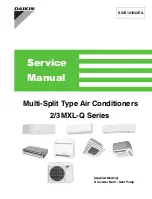
Installation
20
SS-SVX004C-EN
Settings and Adjustments
High/Low Pressure Limit Switches
RCU units are equipped with hermetically sealed high
pressure and low-pressure switches. These switches are
preset by the manufacturer and cannot be adjusted. The
high pressure switch will open to disengage power to the
compressor contactor if the discharge pressure rises
above a specific pressure. The low pressure switch will
open to disengage power to the compressor contactor if
suction pressure drops below a specific pressure. The
system controller should ignore the absence of this signal
during the cold start delay period after starting of a
compressor.
R407C Pressure Switch Settings:
The high-pressure switch opens at 410 psig and has a
manual reset. The low-pressure switch opens at 10 psig
(± 4) and closes at 32 psig (± 5) and has an automatic reset.
Head Pressure Controls
Condensing Unit Fan Cycling
The condensing unit fan cycling switch senses refrigerant
discharge pressure and turns on the condensing unit fan
as required to maintain allowable condensing unit
pressures. This is a high-pressure differential control
switch with SPST contacts and an automatic reset. The
switch activates the condensing unit fan contactor,
cooling the condensing unit to maintain the condensing
temperature when the discharge pressure rises.
R407C Refrigerant:
Factory setting: The fan cycling switch contacts are set to
close on a pressure rise to 320 psig and open at 250 psig.
Set point range is 170 to 375 psig. The differential is set at
70 psi and is adjustable.
Flooded Head Pressure Control
Flooded head pressure control is designed to maintain
head pressure during low ambient temperature
conditions. A head pressure control valve and a receiver is
provided in the refrigeration circuit to back up liquid
refrigerant into the condensing unit coil.
When the receiver pressure drops the valve diverts
discharge gas away from the condensing unit. The liquid
from the condensing unit is restricted, which allows liquid
to flow back up in the condensing unit. Flooding the
condensing unit reduces the area available for heat
transfer thus raising the condensing pressure. As the
pressure increases, the valve diverts the discharge gas to
the condensing unit, which will allow liquid flow from the
condensing unit to the receiver.
When using this method of head pressure regulation there
must be enough refrigerant in the system to ensure
adequate charge at the lowest expected ambient
temperature that the system will be operating.
A receiver is used to store the refrigerant during the time
the condensing unit is not using the extra refrigerant
charge. The head pressure control valve does not begin to
allow refrigerant to pass to the receiver until the discharge
pressure is at least 225 psig for R407C. This valve requires
no adjustment.
RCU units utilize either R407C refrigerant. Refrigerant
charging pressures vary depending on the type of
refrigerant used in the unit. Tables are provided in
“Refrigerant Characteristics,” p. 19
showing the
temperature/pressure characteristics for R407C
refrigerant. Before charging, check the unit nameplate to
confirm the type of refrigerant to use.
Hot Gas Bypass
A full floating hot gas bypass system may be provided as
an option for capacity control and freeze protection. The
hot gas bypass valve allows refrigerant to flow from the
discharge line directly to the suction line. This provides
freeze protection for the evaporator coil by limiting the
minimum refrigerant pressure, preventing the surface
temperature of the evaporator coil from dropping below
32°F.
The hot gas (discharge) regulating valve has a normal
suction pressure control setting of:
R407C - 55 ±2 psig
This is read from the suction (low) side of the compressor
as it operates in full hot gas bypass operation. The valve is
factory set and no adjustment should be necessary. If
adjustment is required, remove the adjustment cap from
the valve. Using a 5/16 inch Allen wrench, turn clockwise
to increase pressure or counterclockwise to lower
pressure.
NOTICE
Compressor Damage!
Do not exceed 20°F superheat. Exceeding this
temperature may cause failure of the compressor.
To prevent overheating the compressor, a small amount
of liquid refrigerant passes through the quench valve and
mixes with the hot gas entering the compressor,
maintaining normal compressor suction pressure and
temperature.
The normal control setting for the quench valve is 20°F
superheat (when there is no call for cooling). The valve is
factory set and no adjustment should be necessary. If
adjustment is required, remove the adjustment cap from
the valve. Turn the adjusting stem clockwise to increase
the superheat and counterclockwise to decrease the
superheat.













































